Public health professionals work to assure that diseases carried by animals do not infect people. Activities include:
- Disease investigation
- Inspection of facilities that house animals
- Issuing of permits and response to complaints from residents regarding animal facilities to ensure compliance with the County Sanitary Code as well as that of the state.
Animal Facilities and Groomer application forms - please contact (914) 864-7359
All permit application fees are non-refundable.
- Application for Animal Facility Permit
- Mobile Groomer application supplement
- Notice to Preparers of Plans for Construction of an Animal Facility
Animal Diseases
- Chronic Wasting Disease (deer)
- Hantavirus (CDC)
- Lymphocytic choriomeningitis (CDC)
- Mpox Information (CDC)
- Rabies
- Tickborne Diseases
- West Nile Virus
Animal Rehabilitators
- Wildlife Rehabilitator registration form
- Nuisance Wildlife Trapper registration form
- Nuisance Wildlife Trapper and Rehabilitator Brochure
Animal Bite/Contact Forms (Rabies)
- Report of Bite/Scratch/Contact Form (fillable pdf) rev. 4/2022
Registries
Anthrax Fact Sheet
Inhalation anthrax is NOT spread from person to person, and there is NO risk to anyone who has had contact with the drummer/drum maker or who attended performances or purchased drums from him.
What is anthrax?
Anthrax is an infectious disease caused by the bacterium Bacillus anthracis, which is capable of forming spores. A spore is a cell that is dormant (asleep) but may come to life in the right conditions. Spores can survive in the environment and remain infectious for a long time, even years.
There are three types of anthrax:
Skin (cutaneous)
Lungs (inhalational)
Stomach and intestines (gastrointestinal)
How is anthrax spread?
Anthrax is usually spread in the form of a spore. (A spore is a dormant form that certain bacteria take when they have no food supply. Spores can grow and cause disease when better conditions are present, as in the human body.) Anthrax is generally spread in one of three ways. Most persons who are exposed to anthrax become ill within one week:
- Skin (cutaneous) - Most anthrax infections occur when people touch contaminated animal products like wool, bone, hair and hide. The infection occurs when the bacteria enters a cut or break in the skin.
- Inhalation (lung) - Some anthrax infections occur when people breathe in the spores of the bacteria. However, the infectious dose for inhalational anthrax is quite high, and requires exposure to a large number of spores (8,000 – 10,000).
- Gastrointestinal - Some people may get anthrax by eating infected meat that has not been properly cooked.
How soon after exposure do symptoms develop?
Symptoms usually develop between one and seven days after exposure but prolonged periods up to 12 days for cutaneous (skin) anthrax and 60 days for inhalation anthrax are possible, though rare.
What are the symptoms of anthrax?
- Skin (cutaneous) - This is the most common form of anthrax. Infection requires a break in the skin. The first symptoms include itching where the skin has been exposed. Then, a large boil or sore appears. The sore becomes covered by a black scab. If not treated, the infection can spread to the lymph nodes and bloodstream.
- Inhalation (lung) - Inhalation anthrax has been very rare in the US. First symptoms include fever, fatigue, malaise, and a cough or chest pain. High fever, rapid pulse, and severe difficulty breathing follow in two to five days. Inhalation anthrax is often fatal.
- Gastrointestinal - This form occurs only after eating infected, undercooked meat. First symptoms include fever, abdominal pain, loose watery bowel movements, and vomiting with blood.
How did this person become infected with anthrax?
The infected person was working with unprocessed animal hides to remove hairs by hand scraping at a workplace in Brooklyn. This process generates dust and debris in the work area. Anthrax spores can be found in animal hides but it is extremely rare that it causes inhalational anthrax.
I’m concerned about getting anthrax. What should I do?
Inhalation (lung) anthrax is not spread from person to person. Even if someone develops symptoms of inhalation anthrax, they are not contagious to other persons. Therefore, anthrax cannot be spread by people sharing office space, living in the same building, or by coughing or sneezing. You cannot be infected with anthrax by having contact with the person diagnosed with anthrax. If you have been in contact with unprocessed animal hides, you can contact your health care provider who may consult the Department of Health if there are any concerns.
As a contact of the anthrax case, do either I or my child need antibiotics to prevent anthrax infection?
No. Anthrax is not spread from person to person such as attending the Kotchenga Dance Troop performance. People should only take antibiotics to prevent or treat anthrax if they have been exposed to the bacteria. The course of antibiotic treatment to prevent anthrax is long (60 days) and people may experience side effects. Although most side effects are mild, severe side effects may occur (such as diarrhea, abdominal symptoms, rash, and allergic reactions) and the use of antibiotics may interfere with other medications you may currently be taking. In addition, the inappropriate use of antibiotics may cause the development of antibiotic-resistant strains of bacteria.
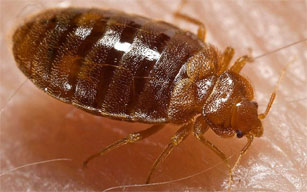
No one wants bed bugs in their home. They are difficult to get rid of and cause annoying, itchy welts. However, bed bugs do not transmit diseases, so they are not considered a public health threat. That's why renters who believe they may have bedbugs should contact their local building department, and not the health department.
Renters who have been unsuccessful in resolving a bed bug infestation with their landlord and/or their local building department can reach out to CLUSTER at 963-6440 to arrange for mediation services. Residents can also contact Legal Services of the Hudson Valley at 949-1305 to see if they qualify for free legal counseling or representation.
Bedbugs can hide in upholstery, and they can enter your home on your suitcases or clothing. Beware of upholstered furniture or beds left curbside for the same reason. Some entomologists even recommend that when you buy new clothes, underwear, socks, sheets or towels, you run them through a hot clothes dryer for 20 minutes, to kill any bed bug eggs that could be hiding there. They can be also be found on wooden slats, springs as well as the bed frame. They can also live in wallpaper crevices, electrical wall plates, light fixtures, wall hangings, cabinetry as well as carpet fibers and wooden floorboards. For their size, common household bed bugs are extremely fast.
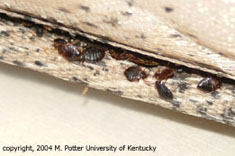 Telltale signs of bedbug infestations are dark spotting and staining, which is the dried excrement of the bugs. Also present will be eggs and eggshells, molted skin of maturing nymphs, and the bugs themselves. Another likely sign of bed bugs is rusty or reddish spots of blood on bed sheets or mattresses.
Telltale signs of bedbug infestations are dark spotting and staining, which is the dried excrement of the bugs. Also present will be eggs and eggshells, molted skin of maturing nymphs, and the bugs themselves. Another likely sign of bed bugs is rusty or reddish spots of blood on bed sheets or mattresses.
Bed bugs prefer to hide close to where they feed. However if necessary, they will crawl more than 100 feet to obtain a blood meal. Initial infestations tend to be around beds, but the bugs eventually may become scattered throughout a room, occupying any crevice or protected location. They also can spread to adjacent rooms or apartments.
Bites and Concerns
Bed bugs usually bite people at night while they are sleeping. They feed by piercing the skin with an elongated break through which they  withdraw blood. Engorgement takes about three to 10 minutes, yet the person seldom knows they are being bitten. Some people develop an itchy welt or localized swelling, while others have little or no reaction. Unlike flea bites that occur mainly around the ankles, bed bugs feed on any bare skin exposed while sleeping (face, neck, shoulder, arms, hands, etc.) The welts and itching are often attributed to other causes such as mosquitoes. For these reasons, bed bug infestations can grow and go undetected for a long time before being noticed.
withdraw blood. Engorgement takes about three to 10 minutes, yet the person seldom knows they are being bitten. Some people develop an itchy welt or localized swelling, while others have little or no reaction. Unlike flea bites that occur mainly around the ankles, bed bugs feed on any bare skin exposed while sleeping (face, neck, shoulder, arms, hands, etc.) The welts and itching are often attributed to other causes such as mosquitoes. For these reasons, bed bug infestations can grow and go undetected for a long time before being noticed.
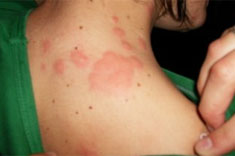
How Infestations Originate
The bugs are efficient hitchhikers and are usually transported in on luggage, clothing, mattresses and furniture. This is a problem for hotels, motels, and apartments, where turnover of occupants is constant. Bed bugs are small, escaping detection after crawling into suitcases, boxes, and belongings. The eggs are almost impossible to see when laid on most surfaces. Purchase or rental of secondhand mattresses, box springs, and furniture is another way that the bugs are transported into non-infested dwellings.
Once bed bugs are introduced, they often spread room to room throughout a building. The level of cleanliness has little to do with most bed bug infestations. Pristine homes, hotels, and apartments have plenty of hiding places and an abundance of warm-blooded hosts.
Controlling Infestations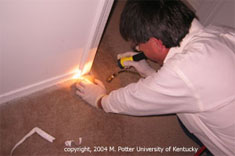 Bed bugs are challenging pests to control. They hide in many tiny places, so inspections and treatments must be thorough. In most cases, it will be prudent to enlist the services of a professional pest control firm. Experienced companies know where to look for bed bugs, and have an assortment of management tools at their disposal. Owners and occupants must remove excess clutter, and in some cases infested mattresses and box springs. Since bed bugs can move from room to room, it may be necessary to inspect adjoining rooms and apartments.
Bed bugs are challenging pests to control. They hide in many tiny places, so inspections and treatments must be thorough. In most cases, it will be prudent to enlist the services of a professional pest control firm. Experienced companies know where to look for bed bugs, and have an assortment of management tools at their disposal. Owners and occupants must remove excess clutter, and in some cases infested mattresses and box springs. Since bed bugs can move from room to room, it may be necessary to inspect adjoining rooms and apartments.
Where They Hide
Bed bugs can live in almost any crevice or protected location. The most common place to find them is the bed. Bed bugs often hide within seams, tufts, and crevices of the mattress, box spring, bed frame and headboard.
A thorough inspection requires dismantling the bed and standing the components on edge. Things to look for are the bugs themselves, and the light-brown, molted skins of the nymphs. Dark spots of dried bed bug excrement are often present along mattress seams or wherever the bugs have resided. Oftentimes the gauze fabric underlying the box spring must be removed to gain access for inspection and possible treatment. Bed bugs also hide among items stored under beds.
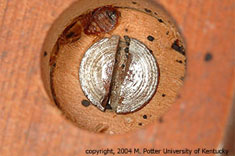 Many areas besides beds, however, can harbor bed bugs. Nightstands and dressers should be emptied and examined inside and out, then tipped over to inspect the woodwork underneath. Oftentimes the bugs will be hiding in cracks, corners, and recesses. Upholstered chairs and sofas should be checked, especially seams, tufts, skirts, and crevices beneath cushions. Sofas can be major bed bug hot spots when used for sleeping.
Many areas besides beds, however, can harbor bed bugs. Nightstands and dressers should be emptied and examined inside and out, then tipped over to inspect the woodwork underneath. Oftentimes the bugs will be hiding in cracks, corners, and recesses. Upholstered chairs and sofas should be checked, especially seams, tufts, skirts, and crevices beneath cushions. Sofas can be major bed bug hot spots when used for sleeping.
Treatment Procedures
It often takes hours to properly inspect and treat a bed bug infestation. Follow-up visits are usually required and owners/occupants have important pre-treatment responsibilities.
- Reduce clutter. Belongings strewn about rooms afford many places for bed bugs to hide, and impedes inspection and treatment.
- Infested bedding and garments must be bagged and laundered (120 degrees F minimum) or discarded since these items cannot be treated with insecticides. Professionals sometimes use high heat blowers to kill off bed bugs and their eggs.
- Smaller items that cannot be laundered can sometimes be de-infested by heating. Individual items, for example, can be wrapped in plastic and placed in a hot, sunny location for at least a few days (the 120 degree F minimum target temperature should be monitored in the center-most location with a thermometer).
- Bed bugs also succumb to cold temperatures below 32 degrees F, but the chilling period must be maintained for at least two weeks.
- Remove bugs and eggs from mattresses, carpet, walls and other surfaces by vacuuming. Pay particular attention to seams, tufts and edges of mattresses and box springs, and the perimeter edge of wall-to-wall carpets. Then, dispose of the vacuum bag and its contents in a sealed trash bag.
- Steam clean your carpets to kill bugs and eggs that vacuuming may have missed.
Brochures
- Preventing and Getting Rid of Bed Bugs Safely (NYCDOH)
- Bed Bug Control (Integrated Pest Management, Cornell Cooperative Extension)
- Chinches Domesticas (Texas Cooperative Extension)
Other Resources

Human Cases:
Avian influenza (bird flu) Type A viruses do not normally infect people, but rare cases of human infection have occurred. Illnesses in humans from avian influenza virus infections have ranged in severity from no symptoms or mild illness (eye infection, upper respiratory symptoms) to severe disease (pneumonia) that resulted in death.
Human infections with avian influenza viruses have most often occurred after close or lengthy unprotected contact with infected birds or places that sick birds or their saliva, mucous and feces have touched. Very rarely, human infections with avian influenza viruses have happened through an intermediary animal, including a cat and a cow.
Human infections with avian influenza viruses can happen when virus gets into a person's eyes, nose or mouth, or is inhaled. This can happen when virus is in the air (in droplets or possibly dust) and a person breathes it in, or possibly when a person touches something that has virus on it and then touches their mouth, eyes or nose.
At this time, the risk to the general public from Avian Influenza is low. The spread of avian influenza viruses from one infected person to a close contact is very rare, and when it has happened, it has not led to continued spread among people.
For the latest on bird flu in the U.S., including regularly updated case counts, visit the CDC’s H5 Bird Flu: Current Situation page.
Cases in Birds and Mammals:
Highly pathogenic avian influenza (HPAI) has been found in poultry and wild birds in Westchester County and throughout the United States. It has also been detected in dairy cattle and in other mammals.
For current reports of HPAI in birds and wildlife, visit the USDA Animal and Plant Health Inspection Service and the NYS Department of Agriculture and Markets.
Report groups of sick or dead birds immediately:
- For poultry, call the NYS Department of Agriculture and Markets at 518-457-3502 or the USDA at 866-536-7593 to report sick birds in your flock, an unexplained high number of deaths, or a sudden drop in egg production.
- For wild birds, call the NYS Department of Environmental Conservation at 718-482-4922 or 518-478-2203. You can also use the link for reporting observations that is available on DEC’s Animal Diseases webpage.
If you find a dead bird on your property:
- Put on gloves, a facemask and eye protection.
- Use a shovel to pick up and place the dead bird in a triple-bagged garbage or contractor bag and discard in an outdoor bin.
- Throw away your gloves and facemask after use.
- Wash your hands and clothing immediately afterwards.
Protect yourself from infection:
- Avoid contact with birds that appear sick or have died.
- If you must have direct/close contact with wild birds, sick or dead poultry, or other animals, wear recommended personal protective equipment (PPE). Wild birds can be infected with avian influenza even if they don't look sick.
- Do not touch surfaces or materials contaminated with saliva, mucous, or feces from wild or domestic birds or other animals with confirmed or suspected HPAI infection.
- Take precautions to protect yourself during and after spending time in areas with geese and other wild bird droppings.
- Do not drink raw milk or consume unpasteurized dairy products like cheese, yogurt and ice cream.
Pasteurization in commercial dairy products uses heat to kill disease-causing bacteria like avian flu, making it safe for consumption. Bird flu is also not a risk to food safety. Poultry and eggs that are safely handled and cooked to an internal temperature of 165 degrees F are safe to eat.
Protect your backyard flock:
- Watch closely for signs of illness in your flock and minimize your flock’s exposure to wild birds and their droppings.
- The state health department advises limiting outdoor access for poultry at this time.
- For more guidance, go to the USDA Defend the Flock
Protect your pets:
- Do not feed pets raw meat/food or unpasteurized dairy products.
- Do not allow pets to drink raw milk.
- Keep pets away from sick or dead birds when they are outside.
Avian Influenza Resources:
Centers for Disease Control
New York State Department of Health
New York State Department of Environmental Conservation
New York State Department of Agriculture
United States Department of Agriculture
American Veterinary Medical Association
Everyone living in Westchester needs to be able to identify a deer tick, even if you do not spend a lot of time outdoors. Know the difference between the deer tick which carries Lyme disease, and a dog tick, which does not carry the disease.

The stages of Ixodes scapularis, the black-legged or deer tick: larva, nymph, adult.

A female black-legged deer tick, Ixodes scapularis.
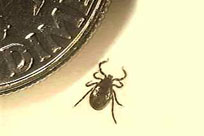
A male deer tick
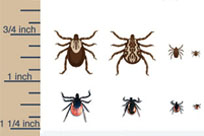
Top Row: Dermacentor variabilis, the American dog tick, which is not thought to transmit Lyme disease. Left to right: adult male, adult male dorsal side, nymph, larva. Adults are most common in May, June, and July. Note that the adult dog ticks are somewhat larger than adult deer ticks, and have characteristic white markings on the dorsal (top) side.
Bottom Row: Ixodes scapularis (dammini), the deer tick which transmits Lyme disease. Left to right: adult female, nymph, younger nymph, larva. Nymphs are most common May through July. Adults appear in the fall and early spring.

An adult deer tick (left) and an engorged deer tick filled with blood (right).

An American dog tick
